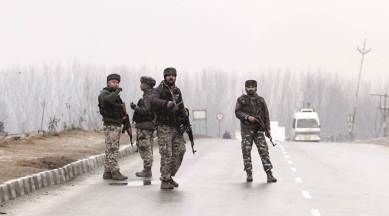Stay updated with the latest - Click here to follow us on Instagram
For CRPF, Pulwama attack a ‘massive setback’, a new challenge
Before Thursday’s attack, the most casualty suffered by CRPF in an attack was on June 25, 2016, when a vehicle was attacked by three LeT militants, leaving eight personnel dead and 22 injured.

Thursday’s suicide attack in Awantipora, in J&K, that left 37 CRPF personnel dead is the biggest attack in terms of casualties that the paramilitary force has suffered in the Valley since it took over law and order duties in the state from the BSF in 2005.
Before Thursday’s attack, the most casualty suffered by CRPF in an attack was on June 25, 2016, when a vehicle was attacked by three LeT militants, leaving eight personnel dead and 22 injured.
Kashmir terror attack LIVE updates
The scale of Thursday’s attack can be gauged from the fact that in the whole of 2018, CRPF did not lose as many men as it did on Thursday. According to Union Home Ministry’s figures, CRPF lost 30 men in terror attacks in 2018.
“It is a massive setback for morale of the force,” a CRPF officer said. “Most men who came under attack on Thursday were returning from leave and were to join duty in Srinagar. It will take some time for the force to recover from it, but we have suffered worse casualties in Chhattisgarh and come out of it.”
Going by casualty figures, CRPF faces graver danger in Maoist terror-affected areas than in J&K. In 2010, during the Chintalnar ambush in the heart of Bastar, Chhattisgarh, the paramilitary force CRPF lost 76 men. Its vehicles, even armoured ones, are often blown up by Maoists in Bastar, and double-figure casualties are not uncommon there.
In fact, before the 2016 killing of Hizb-ul-Mujahideen militant Burhan Wani, which threw the Valley into a violent turmoil, CRPF personnel had begun calling Kashmir a peace posting.
“If a CRPF person had a choice between Kashmir and Chhattisgarh, he would go for Kashmir,” a CRPF officer who has worked in both states said.
Sources said the nature of the attack is also a reason why the Awantipora attack will leave a psychological impact. “This attack is so massive that we have not been able to count the number of bodies yet. Some bodies are totally disfigured; we may have to depend on DNA tests to identify them. We are still trying to figure out which limb belongs to which body,” an officer said.
The CRPF, officials said, is not used to improvised explosive device (IED) attacks in Kashmir, let alone car-borne suicide bombers. IEDs were a regularity in Kashmir during the peak of militancy, but from mid-2000s militant attacks largely centred around gunfight and grenade attacks. IEDs, officials said, have made a comeback following Wani’s killing in 2016.
There was just one IED attack in the Valley in 2017; there were less than 10 such attacks recorded the last year. There have been only three vehicle-borne suicide attacks, sources said, in the history of militancy in Kashmir — none as lethal as Thursday’s attack.
“This brings to the fore a new threat and a new challenge for all security forces in the Valley. We will have to devise ways to counter it,” a CRPF officer said.
There are more than 60 CRPF battalions (60,000 personnel) in J&K, most of them posted in the Valley.